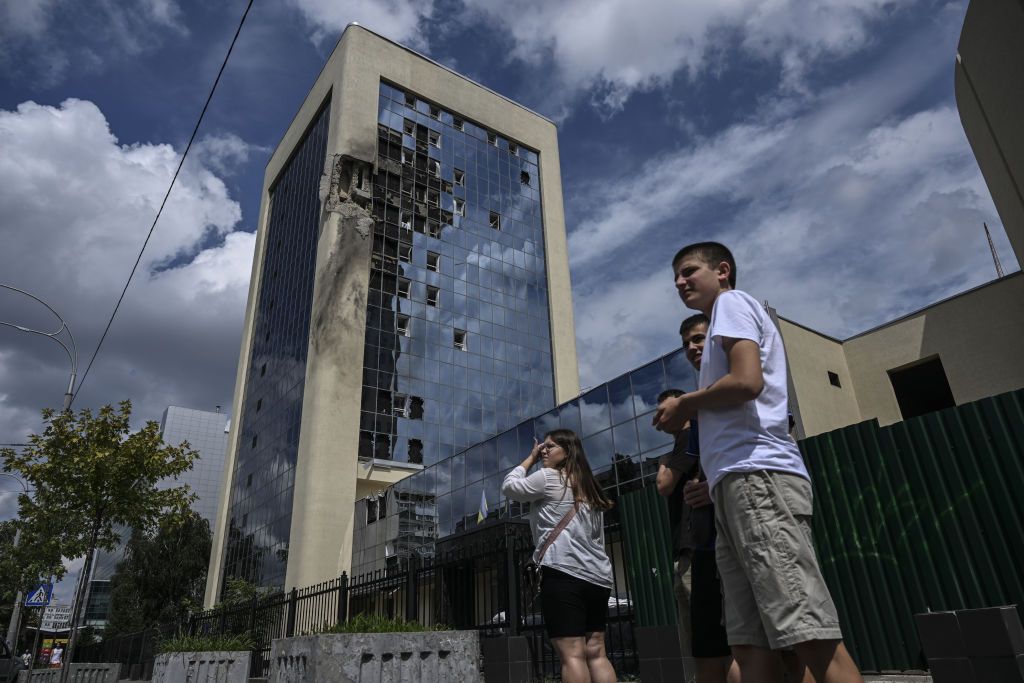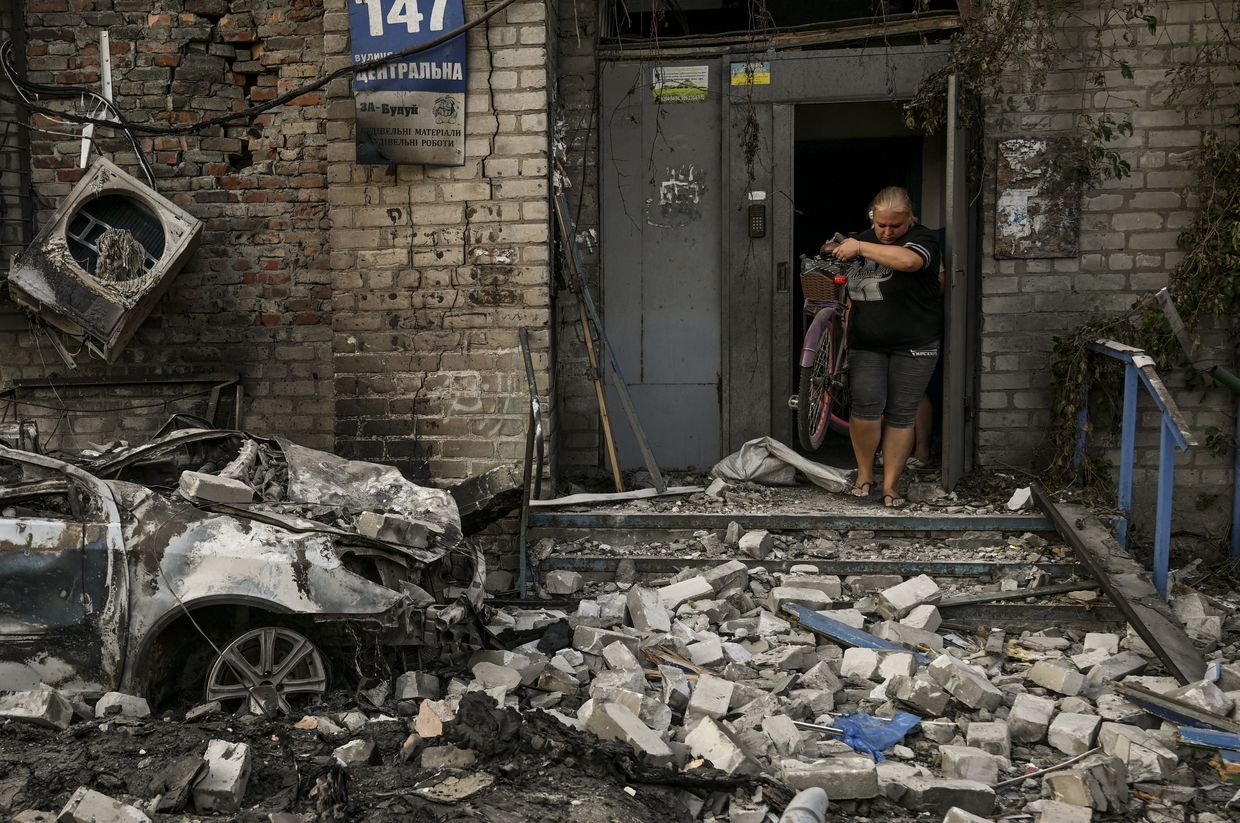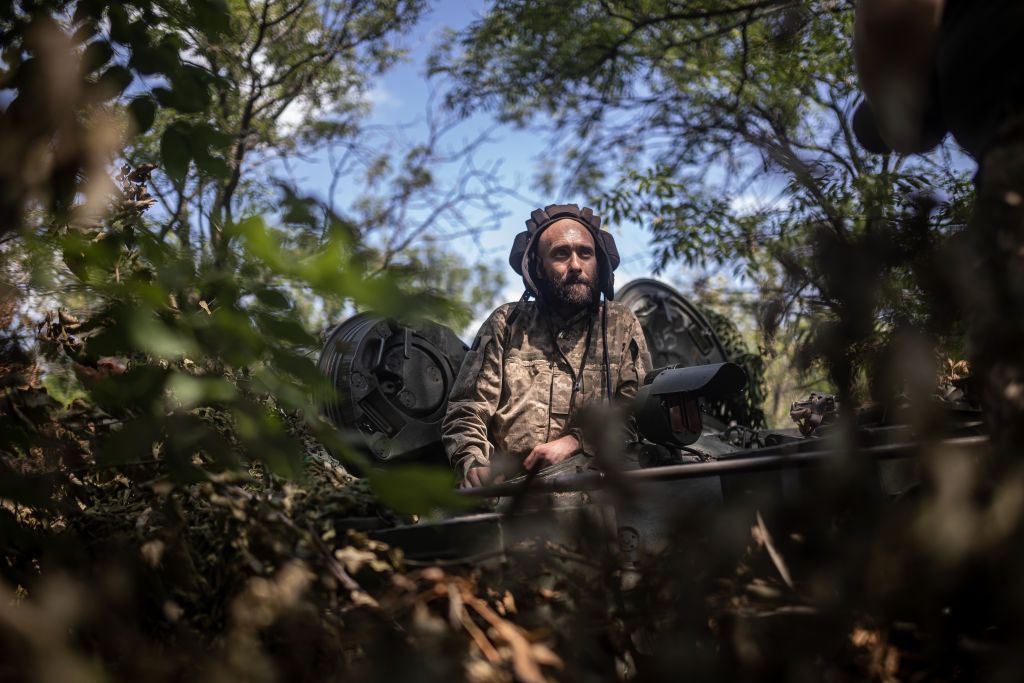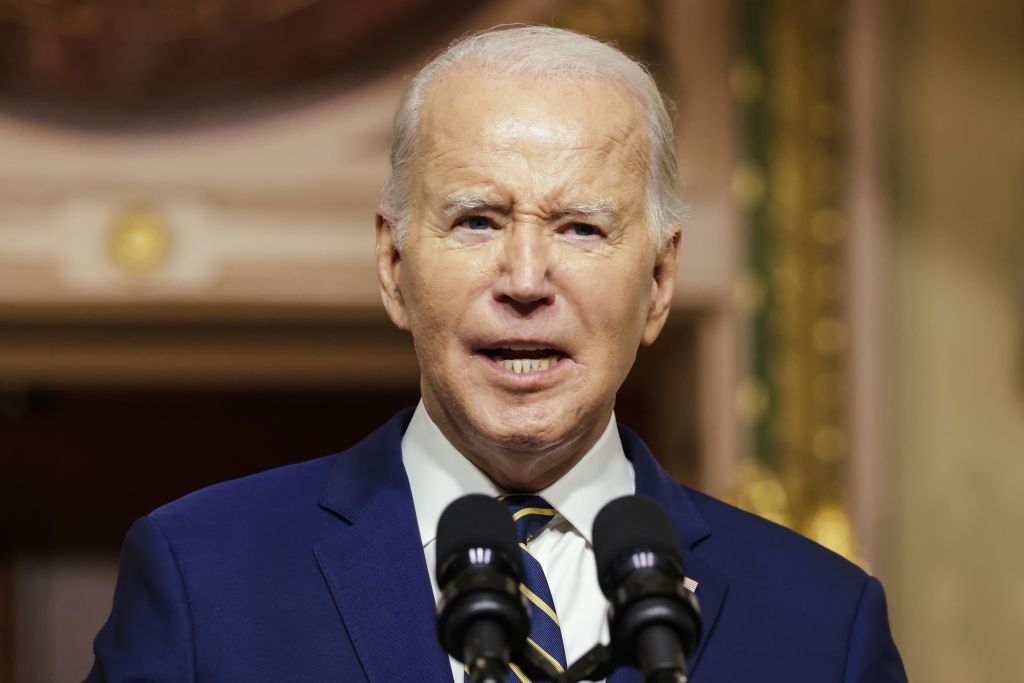Ukraine war latest: Military reports 3 square kilometers’ advance near Bakhmut over last week

Key developments on Aug. 14:
- Defense Ministry: Ukraine liberates 3 square kilometers near Bakhmut in last week
- Air defense downs 15 Shahed drones, 8 Kalibr missiles overnight
- UK Defense Ministry: Russia considers deploying more troops to Dnipro River's east bank
- Military intelligence: Ukraine ready to face any Russian offensive in foreseeable future
- Minister: Germany plans $5.5 billion in annual military aid for Ukraine until 2027
- US announces $200 million military aid package for Ukraine.
Ukrainian forces have liberated three square kilometers of land near Bakhmut in Donetsk Oblast over the last week, Deputy Defense Minister Hanna Maliar said on Aug. 14.
Maliar said that a total of 40 square kilometers on the southern flank of the Bakhmut area had been regained by Ukrainian forces. Bakhmut fell to Russian forces in late May.
She added that Russian forces attempted to regain positions they had previously lost in the areas west of Klishchiivka, Andriivka, and Kurdiumivka.
On Aug. 8, Serhii Cherevatyi, spokesman for Ukraine's Eastern Military Command, said that Ukrainian forces continued to hold the initiative on the battlefield around Bakhmut despite heavy Russian artillery fire.
The Bakhmut area remains one of the main sectors of the ongoing Ukrainian counteroffensive.
Maliar said on Aug. 1. that Russia is concentrating its forces along the eastern front line, namely near Kupiansk, Lyman, and Svatove, trying to pull Ukrainian forces away from Bakhmut and stop their advance in that area.
Air Force: Ukraine downs 15 Shahed drones, 8 Kalibr missiles overnight
Russia attacked Ukraine in several waves overnight on Aug. 14 using Iranian-made kamikaze drones and cruise missiles, the Air Force reported.
According to the report, Russia used 15 Shahed-136/131 drones and eight Kalibr missiles, all of which were shot down.
The drones were launched from Primorsko-Akhtarsk, a town on the Azov Sea coast in Russia's Krasnodar Krai, and the missiles flew from a ship stationed near Yalta in Russian-occupied Crimea, the military wrote.
Fragments of missiles and drones fell in Odesa, causing fires in several city locations, added the Air Force. First responders are working on the spots.
According to Odesa Oblast Governor Oleh Kiper, the debris damaged an educational institute's dormitory, a residential building, and a supermarket.
Three employees of the supermarket were injured, Kiper said in his update on Telegram.
The blast wave knocked out windows in several buildings and damaged cars parked nearby, the official added.
As of 11 a.m. local time, damages to 203 buildings were recorded in Odesa due to Russia’s overnight aerial attack, the Odesa City Council reported on Aug. 14.
The local authorities wrote that seven educational institutions, including a cultural heritage site, and four medical facilities were damaged.
Some commentators speculated that such a level of destruction, particularly in photos depicting local supermarket Fozzy, appears to have been caused by a direct hit by a drone or a missile.
In a comment for the Ukrainian outlet Babel, the Air Force spokesperson Yurii Ihnat reiterated that the air defenses downed all the targets, adding that a large-scale fire destroyed Fozzy.
Shahed drones fly at low altitudes and create “a very large” scattering of burning debris when they are shot down, causing an especially destructive blast wave, Ihnat explained.
The air defense forces had no choice but to shoot down the Kalibr missiles "just above the city, above residential areas," the Southern Command spokesperson Natalia Humeniuk said on national television, as cited by Hromadske.
Following Moscow’s unilateral withdrawal from the Black Sea Grain Agreement, Russian forces have intensified attacks against Ukraine’s southern city of Odesa, targeting critical port and grain infrastructure.
The July strikes also damaged Odesa’s historical center, named a UNESCO World Heritage Site in January 2023.
UK Defense Ministry: Russia considers deploying more troops to Dnipro River's east bank
After Ukrainian cross-river raids in Kherson Oblast, Russia has faced the dilemma of whether to strengthen this area or deploy forces in the main sectors of Ukraine's counteroffensive operations, the U.K. Defense Ministry reported on Aug. 14.
Over the last week, small-scale combat has intensified along the banks of the lower reaches of the Dnipro River, the ministry wrote in its latest intelligence update.
According to the update, Ukrainian forces have carried out raids and tried to gain a foothold at new locations on the Russian-occupied east bank.
In addition, Ukrainian troops have expanded the bridgehead they have been holding next to the destroyed Antonivsky Bridge since June 2023, reads the report.
"Some of these operations likely took advantage of a local Russian force rotation."
The two sides also continue to fight for control over small islands in the Dnipro estuary, the U.K. Defense Ministry added.
On Aug. 9, the Institute for the Study of War (ISW) reported that Ukrainian forces had conducted a cross-river raid deep into Russian-held territories in Kherson Oblast, managing to breach Russian defenses and push forward by up to 800 meters.
He added that the operation's participants had taken 16 Russian soldiers as prisoners and brought them back to the government-controlled side of the river.
The Kyiv Independent's source in Ukraine's Armed Forces later confirmed the information.
On Aug. 9, the Kyiv Independent's source in Ukraine's Armed Forces confirmed that Ukraine had successfully conducted a raid deep into Russian-held territories across the river.
The source, granted anonymity to speak freely about Ukraine's military operations, told the Kyiv Independent that Ukraine's military had taken 16 Russian soldiers as prisoners and brought them back to the government-controlled side of the river.
Deputy Defense Minister Hanna Maliar sought to tamp down speculations about a Ukrainian raid across the Dnipro River in Kherson Oblast.
"There are no reasons for excitement. I just returned from those places," Maliar wrote. "Yes, certain units performed a certain task there," she added.
"In order to get there, and not to be destroyed and also to gain a foothold, you need to clear the territory and repel the enemy," Maliar said.
"We are saving our people, which is why we're using counter-battery fire," she added.
Ukrainian forces in the area told the Kyiv Independent that they have been conducting small raids across the river for months under the cover of night.
Ukraine ready to face any Russian offensive in foreseeable future, says military intelligence
Ukraine is ready for any large-scale offensives that Russia could potentially launch in the near future, military intelligence (HUR) General Vadym Skibitskyi said on Aug. 14, commenting on recent rumors about such attacks in Western media.
Moscow is currently exerting efforts to slow down Ukraine's counteroffensive, and destroy the country's internal unity and the trust between Kyiv and its partners, Skibitskyi told Obozrevatel in an interview.
"They want to win time to restore weapons stockpiles and the fighting capacity of their occupying forces. Our task is to prevent this," the military intelligence officer said.
"Yes, it is not easy for our security and defense forces, but we have no choice but to continue the fight and we are moving forward wisely and courageously."
Skibitskyi pointed out that despite predictions of a large-scale Russian offensive during the last winter, such plans have failed.
Since mid-July, Russian forces have been concentrating around Kupiansk in Kharkiv Oblast, trying to regain the positions lost during the Ukrainian surprise counteroffensive last autumn.
On July 17, Serhii Cherevatyi, spokesperson for Ukraine's Eastern Military Command, said that Russia was concentrating "more than 100,000 personnel, more than 900 tanks, more than 555 artillery systems, and 370 multiple rocket launchers" in the Lyman-Kupiansk direction.
The Institute for the Study of War (ISW) said in its analysis on Aug. 13 that according to Russian military bloggers, Moscow's troops are slowly advancing toward Kupiansk but still require reinforcements to break through the Ukrainian defenses.
The Russian command is not currently able to deploy more forces in the Kupiansk direction for this purpose, the ISW added.
Minister: Germany plans $5.5 billion in annual military aid for Ukraine until 2027
Germany plans to provide Ukraine with 5 billion euros ($5.5 billion) in annual military aid until 2027, German Finance Minister Christian Lindner said on Aug. 14, Forbes Ukraine reported.
The decision still needs to be approved by the German Parliament, Lindner said during a joint press conference with Ukrainian Finance Minister Serhii Marchenko in Kyiv.
The minister noted that apart from military support, Berlin's aid for Ukraine has also included humanitarian assistance, support for Ukrainian migrants living in Germany, and the country's contributions to the International Monetary Fund (IMF).
Since the start of the Russian full-scale invasion of Ukraine, Germany's support amounted to 22 billion euros ($24 billion), Lindner added.

Germany's finance minister arrived in Kyiv earlier on Aug. 14 for his first official visit to Ukraine since the start of Russia's full-scale invasion.
Lindner added that he hoped the question of Germany supplying Taurus long-range cruise missiles could be resolved soon, and that he personally supported the weapons' delivery.
In July, German Chancellor Olaf Scholz said that Germany expects to provide Ukraine with $19 billion, or 17 billion euros, in arms deliveries until 2027.
Scholz said the calculations began in 2022, when Russia launched its full-scale invasion, and track projected spending until the year 2027.
The $19 billion estimate only accounts for weapons donated or financed by Germany and does not include other forms of aid to Ukraine.
US announces $200 million military aid package for Ukraine
The U.S. has announced a $200 million military aid package for Ukraine, including munitions for Patriot air defense systems and HIMARS, as well as other support, the Pentagon said on Aug. 14.
"Air defense, anti-armor, and munitions will keep the Ukrainian armed forces in the fight to defend their country's sovereignty, territory, and people," U.S. State Secretary Anthony Blinken tweeted.
The 44th tranche of U.S. weapons support for Ukraine includes ammunition for Patriots and HIMARS, 155mm and 105mm artillery shells, 120mm tank ammunition, Javelin anti-tank systems, TOW anti-tank missiles, and other anti-tank munitions and systems.
The Pentagon has further pledged 37 logistics vehicles, 58 water trailers, over 12 million rounds of small arms ammunition and grenades, mine clearing equipment, explosives for clearing obstacles, spare parts, and other field equipment.
U.S. State Department spokesperson Matthew Miller said during a press briefing on Aug. 8 that next to this latest package, the U.S. is considering the transfer of new missiles and defense systems to Ukraine.
The spokesperson did not respond to a question about whether these new systems include the much-anticipated long-range ATACMS missiles.
The new funds will be allocated thanks to the $6.2 billion "accounting error" discovered in June.
According to Pentagon spokesperson Sabrina Singh, the U.S. Defense Department overestimated the value of arms sent to Ukraine over the past two years by $6.2 billion, freeing up additional funds for Ukraine military aid.
The U.S. announced its previous package for Ukraine worth $400 million on July 25, including additional munitions for Patriot air defense systems, NASAMS, HIMARS, as well as Stingers, Javelins, and other weapons.



















